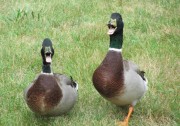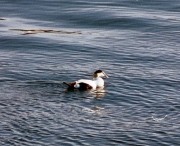An article c. 1997 by Pat Corr (retired)
Wildlife Biologist,
Maine Department of Inland Fisheries and Wildlife
DABBLING DUCKS
Description
Dabbling ducks common in Maine are the American black duck, the mallard, green-winged teal, blue-winged teal, and wood duck. Northern shoveler, Northern pintail, gadwall, European widgeon, American widgeon and fulvous whistling ducks also occur in Maine, but are less common.
While many mallards migrate south in winter, a susbsantial number in southern Maine remain as year-round residents. Dabblers feed by dabbling at the water surface or by “upending” submerging their head and pitching their tail up. They will also feed on land in open areas.
Several dabblers have bills adapted for straining tiny items out of muddy water. Females are mostly brown with spots or stripes, which helps them blend in when nesting. Males are generally more brightly colored, but some have similar plumage as the female (e.g. black duck). The male wood duck in its breeding plumage has earned the title of the most beautiful duck in North America. The crest of the head is iridescent green in front to purplish in the rear, burgundy feathers are found behind each eye, and the sides of the head are purple, blue-green, and bronze.
Natural History
Habitat and Food Habits. Black ducks, mallards, and pintails utilize a range of habitats (brackish, salt, and freshwater marshes, lakes, rivers, and beaver ponds), which leads to a diverse diet ranging from seeds of aquatic plants, to cultivated crops, to mollusk. Mollusk are less important part of mallards and pintails diet.
Wood ducks inhabit streams, rivers, flood plains, lakes, swamps, and beaver ponds. Acorns, when available, are the favored food of wood ducks. Green-winged and blue-winged teal have similar food habits and often feed together on mud flats and shallow marshes. Green-winged teal are primarily vegetarians, whereas, blue-winged teal will eat some animal life.
Reproduction. Dabbling ducks first breed as one-year olds and begin nesting in March and April. The blue-winged teal is the last to reach its breeding grounds and thus nests the latest of all dabblers. Dabbling ducks form short pair bonds that weaken during the onset of incubation. Some pair bonds only last a few days after incubation begins whereas others maintain the bond up to 3 weeks into incubation.
Dabbling ducks lay a clutch of 5-15 eggs with the average nest having 10 eggs. Incubation and nest success is variable among species. Hens incubate eggs for 22-30 days. Nest success ranges from 32-75%. Gadwell’s have the highest nesting success and green-winged teal have the lowest. Green-winged teal nesting success may be an underestimate, because nests and broods are difficult to observe.
Most wood ducks establish pair bonds in late fall and winter and migrate to their breeding areas in pairs. Drake woodies remain with their mates longer than most ducks, allowing them opportunity to renest if their initial nest is lost. Wood ducks incubate their eggs for 28-37 days longer than other dabblers. Like common and hooded mergansers and common goldeneyes, wood ducks nest in tree cavities. A wood duck’s average clutch size is 8-10 eggs. However, more eggs may be in a nest due to “dump nesting”. Dump nesting refers to the activity of another duck laying her eggs in an established nest and leaving. The hen who established the nest may incubate the eggs or abandon the nest.
DIVING DUCKS
Description
Diving ducks common in Maine are ring-necked ducks, common goldeneyes, buffleheads, common eiders, hooded mergansers, and common mergansers.
Greater scaups, lesser scaups, Barrow’s goldeneyes, red-breasted mergansers, canvasbacks, redheads, and ruddy ducks are less common in Maine.
Diving ducks feed by diving from the surface and swimming underwater. They propel themselves through water with powerful strokes of their feet. Some also hold their wings partly open when submerged. Females tend to be evenly colored with shades of brown and, unlike female dabbling ducks, they do not have spots and stripes. Males are strikingly patterned in black and white. Mergansers are the only ducks that specialize in eating fish, and their bills are serrated to help grasp slippery fish.
Natural History
Habitats and Food Habits. The diet of diving ducks consists of aquatic vegetation (pondweeds, wild celery, delta duck potato, bulrus seeds, widgeon grass, eelgrass, etc.) and animal life (aquatic insects, fish, and mollusk). Ring-necks and redheads typically feed in shallower water, sometimes so shallow they do not need to dive. Merganser’s diet consist primarily of fish and crustaceans, and the hooded merganser has the most diverse diet among the mergansers.
Greater scaup feed on both plant and animal life, but clams constitute a major portion of their diet. Lesser scaup, with the exception of sea ducks, feed in deeper water than any other diver, typically 10-25 feet deep. Lesser scaup feed primarily on animal life.
Reproduction. Diving ducks typically first breed at 1 year of age, however scaup do not breed until 2 years of age. Diving ducks begin pairing in late winter, and pair bonds are generally established by early spring. Diving ducks have a strong homing ability with a large percentage of them returning to the same breeding areas each year. Hens begin nesting as early as April and as late a June with lesser scaup nesting late.
The average nest has 9 eggs and hens incubate their eggs for 21-29 days. The hatching rate of eggs is variable among diving ducks ranging from 25-70%. Both scaup species have the lowest nesting success rate. Nest failure is caused by predation, flooding, and desertion. Predation is the greatest factor attributed to nest failure.
Diving ducks may renest if they lose their nest early in the breeding season; but mergansers do not renest after loosing their initial nest, because males leave the breeding areas early. Mergansers breed later (2 years), have longer incubation period (22-37 days), and nest earlier (February to April) than other divers. Like other diving ducks, they have strong homing instincts and produce similar clutch sizes.
More about birds.
Source: Closely followed with some editorial and content changes from “Ducks” at http://www.maine.gov/ifw/wildlife/species/waterfowl/#ducks (accessed September 17, 2011)
More Videos!
Additional resources
Crenshaw, William James. Relocating Broods of Wild Ducks to Establish Breeding Populations. 1974. (Thesis (M.S.) in Wildlife Management–University of Maine, 1974.) [Orono. University of Maine. Raymond H. Fogler Library. Special Collections.]
Korschgen, Carl E. Breeding Stress of Female American Eiders (Somateria mollissima dresseri Sharpe). 1976. (Thesis (Ph.D.) in Forest Resources–University of Maine, 1976.) [Orono. University of Maine. Raymond H. Fogler Library. Special Collections.]
Migratory Game Birds. [By Howard E. Spencer, Patrick O. Corr and Gary Donovan.] Augusta, Me. Maine Department of Inland Fisheries and Wildlife. Divisions of Planning and Coordination and Wildlife. 1975.
Mittelhauser, Glen Howard. The Winter Ecology of Harlequin Ducks in Coastal Maine. 2000. (Thesis (M.S.) in Zoology–University of Maine, 2000.)[Orono. University of Maine. Raymond H. Fogler Library. Special Collections.]
Norton, Arthur Herbert. The Pintail Duck (Dafila acuta) in Winter near Porland, Maine. Washington, D.C. American Ornithologists’ Union [etc.]. 1912.
Wildlife Division Research & Management Report. Various Years. Augusta. Maine Department of Inland Fisheries and Wildlife. http://www.mefishwildlife.com




